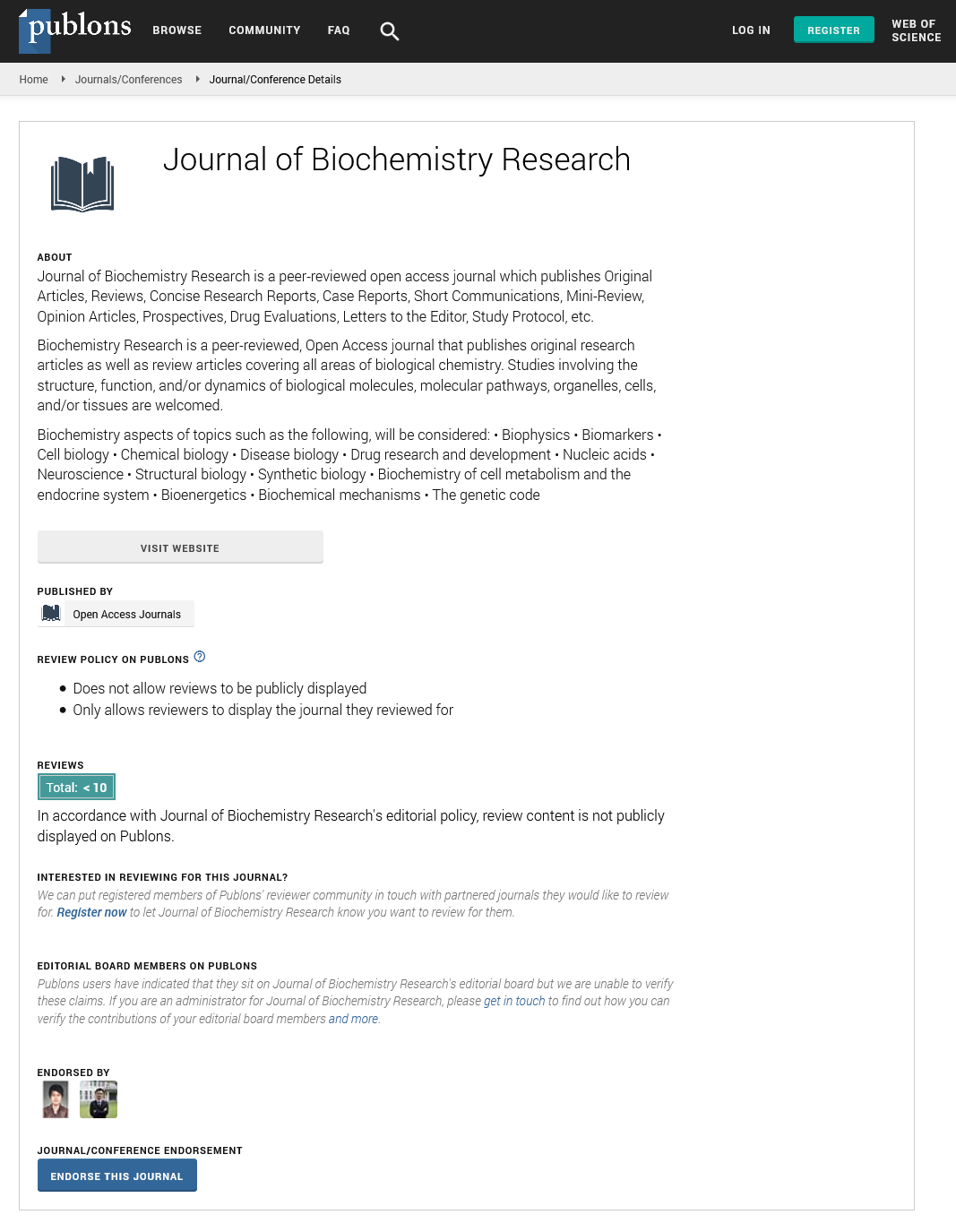Review Article - Journal of Biochemistry Research (2023) Volume 6, Issue 2
Molecular Pathways: Organelles and Endoplasmic Reticulum
Dr. Rajmund Fletcher*
Department of Biochemistry, Molecular Pathways, University of Whiteland, Nigeria
Department of Biochemistry, Molecular Pathways, University of Whiteland, Nigeria
E-mail: fletcher.r@gmail.com
Received: 03-April-2023, Manuscript No. oabr-23-96863; Editor assigned: 05-April-2023, PreQC No. oabr-23- 96863; Reviewed: 19-April-2023, QC No. oabr-23-96863; Revised: 21-April-2023, Manuscript No. oabr-23-96863 (R); Published: 28-April-2023; DOI: 10.37532/ oabr.2023.6(2).38-40
Abstract
Molecular pathways are intricate systems of molecular interactions that occur within cells, driving various cellular processes such as growth, differentiation, and metabolism. These pathways involve the coordinated activity of numerous proteins, enzymes, and signaling molecules that are organized into distinct signaling cascades. Understanding the molecular pathways that regulate cellular functions is essential for the development of new therapeutics and for advancing our understanding of biological systems. Organelles are specialized compartments within cells that perform specific functions. Each organelle is enclosed by a membrane that separates its contents from the cytoplasm of the cell. The various organelles within cells include the nucleus, mitochondria, endoplasmic reticulum, Golgi apparatus, lysosomes, and peroxisomes. Each organelle has its unique set of proteins and enzymes that function in a coordinated manner to carry out specific cellular functions. The importance of organelles in cellular function is highlighted by their involvement in numerous diseases, including cancer, neurodegenerative disorders, and metabolic disorders.
Keywords
Molecular pathways • Cells growth • Differentiation and metabolism • Numerous proteins • Enzymes
Introduction
The interactions between molecular pathways and organelles are crucial for maintaining cellular homeostasis. Many molecular pathways, such as the signaling pathways involved in cell growth and proliferation, rely on the proper functioning of specific organelles [1]. For example, the endoplasmic reticulum is involved in the folding and modification of proteins that are critical components of the signaling pathways involved in cell growth and proliferation. The mitochondria, on the other hand, play a central role in energy metabolism and are involved in many molecular pathways that regulate cellular metabolism. The relationship between molecular pathways and organelles is also critical for the response of cells to environmental stresses such as hypoxia, oxidative stress, and nutrient deprivation [2]. Many molecular pathways involved in stress response rely on the proper functioning of specific organelles. For example, the unfolded protein response, which is activated in response to endoplasmic reticulum stress, involves a coordinated response between the endoplasmic reticulum and the nucleus. Similarly, the response to oxidative stress involves a complex interplay between the mitochondria, lysosomes, and peroxisomes.
Molecular pathways and organelles are fundamental components of cellular biology. These structures and processes play critical roles in the proper functioning of cells, as they facilitate the complex biochemical reactions and functions required for the survival and growth of organisms. Molecular pathways refer to the interconnected series of biochemical reactions that occur within cells to carry out specific functions. These pathways often involve the activation or inhibition of enzymes, the binding of signaling molecules to receptors, and the transport of molecules across cellular membranes [3]. Examples of molecular pathways include metabolic pathways, such as glycolysis and the citric acid cycle, and signaling pathways, such as the MAPK pathway and the PI3K/AKT pathway. Organelles, on the other hand, are specialized substructures within cells that carry out specific functions. These structures are surrounded by membranes that help to compartmentalize the different cellular processes, allowing them to occur simultaneously without interference. Some examples of organelles include the nucleus, which houses the cell’s genetic material, the mitochondria, which produce energy for the cell, and the endoplasmic reticulum, which is involved in protein synthesis and folding [4].
Molecular pathways and organelles
Molecular pathways and organelles are two fundamental components of cells that work together to carry out various biological processes. Molecular pathways refer to a series of biochemical reactions that occur within a cell to achieve a specific physiological or biochemical function [5]. On the other hand, organelles are specialized structures within a cell that perform specific functions required for the survival and normal functioning of the cell. In this article, we will delve deeper into the workings of molecular pathways and organelles, their significance, and how they work together to ensure cellular homeostasis.
Molecular Pathways
Molecular pathways are a series of biochemical reactions that are tightly regulated to achieve a specific biological function. These pathways may be linear, branched, or cyclical, and are often composed of several enzymatic reactions that are catalyzed by specific proteins [5]. These proteins can be enzymes, receptors, ion channels, or transporters, and their activity is regulated by various factors such as post-translational modifications, protein-protein interactions, and changes in the cellular environment.Molecular pathways are essential for various cellular processes, such as metabolism, signaling, and gene expression [6]. For example, the glycolytic pathway is a series of enzymatic reactions that convert glucose into pyruvate, which is a precursor for the synthesis of adenosine triphosphate (ATP), the main energy currency of the cell. Another example is the mitogenactivated protein kinase (MAPK) pathway, which is a signaling pathway that is activated in response to various extracellular stimuli, such as growth factors, cytokines, and stress, and regulates various cellular processes such as cell growth, differentiation, and apoptosis [7].
Organelles: Organelles are specialized structures within a cell that perform specific functions required for the survival and normal functioning of the cell. They are separated from the cytoplasm by lipid membranes that allow them to maintain a specific microenvironment, which is essential for their function [8]. There are several organelles within a cell, each with a specific function. Some of the major organelles are:
Nucleus: The nucleus is a membrane-bound organelle that contains the genetic material of the cell in the form of DNA. It is responsible for regulating gene expression and DNA replication.
Mitochondria: Mitochondria are membranebound organelles that are responsible for the production of ATP, the main energy currency of the cell, through oxidative phosphorylation [9]. Endoplasmic Reticulum (ER): The ER is a membrane-bound organelle that is involved in the synthesis and folding of proteins and lipids. It is divided into two regions, the rough ER and the smooth ER, based on the presence or absence of ribosomes on its surface.
Golgi Apparatus: The Golgi apparatus is a membrane-bound organelle that is involved in the modification, sorting, and packaging of proteins and lipids for transport to various destinations within the cell or outside the cell. Lysosomes: Lysosomes are membrane-bound organelles that contain enzymes that degrade various macromolecules such as proteins, lipids, and carbohydrates.
Peroxisomes: Peroxisomes are membrane-bound organelles that contain enzymes that are involved in the detoxification of harmful substances such as hydrogen peroxide and the synthesis of certain lipids.
Significance of Molecular Pathways and Organelles
Molecular pathways and organelles are essential components of cells that work together to ensure cellular homeostasis [10]. They allow cells to carry out various biological processes such as metabolism, signaling, and gene expression, which are essential for the survival and normal functioning of the cell. Without these pathways and organelles, cells would not be able to carry out these processes and would eventually die.
Conclusion
Molecular pathways and organelles are two essential components of cellular function. The intricate relationship between these two components is essential for the proper functioning of cells and for the response of cells to environmental stresses. The study of molecular pathways and organelles is critical for advancing our understanding of biological systems and for the development of new therapeutics for numerous diseases. the study of molecular pathways and organelles is an essential aspect of modern biology. These intricate processes and structures are responsible for maintaining the homeostasis of the cell and the overall health of the organism.
Molecular pathways are complex networks of interactions between molecules that regulate and control various cellular processes, including metabolism, cell growth, and division. These pathways involve a vast array of proteins, enzymes, and signaling molecules that work together to transmit information and carry out specific functions. Dysregulation of these pathways can lead to various diseases, including cancer, diabetes, and neurodegenerative disorders. Organelles, on the other hand, are specialized structures within cells that perform specific functions. These structures include the nucleus, mitochondria, endoplasmic reticulum, Golgi apparatus, lysosomes, and peroxisomes, among others. Each organelle has a unique structure and function, and their proper functioning is essential for the overall health of the cell and the organism. The study of molecular pathways and organelles has advanced significantly in recent years due to technological advances such as high-throughput sequencing, proteomics, and imaging techniques. These tools have allowed scientists to study these processes and structures in unprecedented detail, leading to a better understanding of their roles in health and disease. Furthermore, the study of molecular pathways and organelles has led to the development of new therapies and treatments for various diseases. For example, the discovery of the role of specific pathways in cancer has led to the development of targeted therapies that can selectively kill cancer cells while sparing healthy cells. Similarly, the study of organelles such as mitochondria has led to the development of treatments for mitochondrial disorders.
The study of molecular pathways and organelles is a crucial aspect of modern biology. These processes and structures play essential roles in maintaining the health of cells and organisms, and their dysregulation can lead to various diseases. The continued advancement of technology and research in this field will undoubtedly lead to new insights and treatments for a wide range of diseases, benefiting human health and wellbeing.
References
- Carrillo JE, Carrillo VA, Perez HR et al. Defining and targeting health care access barriers. J Health Care Poor Underserved. 22,562-75 (2011).
- Lewis RJ, Dutertre S, Vetter I et al. Conus venom peptide pharmacology. Pharmacological Reviews. 64, 259-98 (2012).
- Kobayashi H. Airway biofilms: implications for pathogenesis and therapy of respiratory tract infections. Respiratory medicine. 4, 241-253 (2005).
- Chandalia M, Lutjohann D, von Bergmann K et al. Beneficial effects of high dietary fiber intake in patients with type 2 diabetes mellitus. N Engl J Med. 342, 1392-8 (2000).
- Schwartz SE, Levine RA, Weinstock RS et al. Sustained pectin ingestion: effect on gastric emptying and glucose tolerance in non-insulin-dependent diabetic patients. Am J Clin Nutr. 48, 1413-7 (1988).
- Simó R, Hernández C, Treatment of diabetes mellitus: general goals, and clinical practice management. Revista Espanola de Cardiologia. 55, 845-860 (2002).
- Makam AN, Nguyen OK. An Evidence-Based Medicine Approach to Antihyperglycemic Therapy in Diabetes Mellitus to Overcome Overtreatment. Circulation. 135, 180-195 (2017).
- Meng Y, Bai H, Wang S et al. Efficacy of low carbohydrate diet for type 2 diabetes mellitus management: A systematic review and meta-analysis of randomized controlled trials. J Diabetes Res. 131, 124-131 (2017).
- Roberts CK, Won D, Pruthi S et al. Effect of a short-term diet and exercise intervention on oxidative stress, inflammation, MMP-9, and monocyte chemotactic activity in men with metabolic syndrome factors. J Appl Physiol. 100, 1657-65 (2006).
- Brand-Miller J, Foster-Powell K, Nutr M et al. Diets with a low glycemic index: from theory to practice. Nutrition Today. 34,64-72 (1999).
Indexed at, Google Scholar, Crossref
Indexed at, Google Scholar, Crossref
Indexed at, Google Scholar, Crossref
Indexed at, Google Scholar, Crossref
Indexed at, Google Scholar, Crossref
Indexed at, Google Scholar, Crossref
Indexed at, Google Scholar, Crossref
Indexed at, Google Scholar, Crossref
Indexed at, Google Scholar, Crossref


